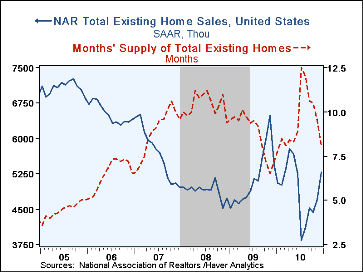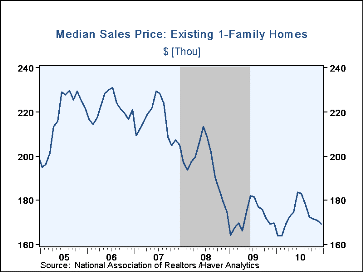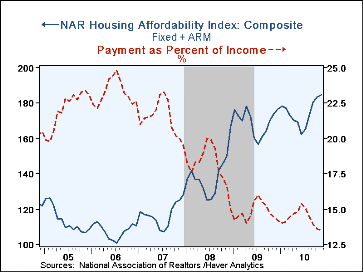 Global| Jan 20 2011
Global| Jan 20 2011U.S. Existing Home Sales Jump
by:Tom Moeller
|in:Economy in Brief
Summary
The National Association of Realtors reported that December sales of existing homes jumped 12.3% to 5.280M following an upwardly revised 6.1% November increase. December sales exceeded Consensus expectations for 4.86M. For the full [...]
 The National Association of Realtors reported that December sales of existing
homes jumped 12.3% to 5.280M following an upwardly revised 6.1% November
increase. December sales exceeded Consensus expectations for 4.86M. For the full
year, sales fell 4.7% from 2009. Total sales include sales of condos and co-ops.
Sales of existing single-family homes alone rose 11.8% (-2.5% y/y) from November
to 4.64M. (These data have a longer history than the total sales series.) Sales
of condos and co-ops jumped 16.4% m/m but rose 2.2% during all of 2010.
The National Association of Realtors reported that December sales of existing
homes jumped 12.3% to 5.280M following an upwardly revised 6.1% November
increase. December sales exceeded Consensus expectations for 4.86M. For the full
year, sales fell 4.7% from 2009. Total sales include sales of condos and co-ops.
Sales of existing single-family homes alone rose 11.8% (-2.5% y/y) from November
to 4.64M. (These data have a longer history than the total sales series.) Sales
of condos and co-ops jumped 16.4% m/m but rose 2.2% during all of 2010.
The median price of all existing homes fell 0.8% m/m to $168,800, the sixth consecutive monthly decline. Though prices remained off one-quarter from the 2007 peak, they have risen a modest 2.6% from the February low. The price of a single-family home fell 0.9% last month to $169,300 (-0.2% y/y). Earlier price weakness sharply raised home affordability to a record high, up more than two-thirds from the 2006 low. Also of help was a drop in the mortgage interest rate to a new low of 4.54% during November. The median family income for existing home buyers was $61,819 and mortgage payments amounted to 13.5% of that total.
The number of unsold homes (single-family & co-ops) for sale fell in December to 3.560 mil. but were up 8.4% y/y. At the current sales rate, the months' supply of homes on the market fell m/m to 8.1, near the cycle low and well off the record high of 12.5. For single-family homes, the inventory also fell m/m to a 7.7 months' supply.
The data on existing home sales, prices and affordability can be found in Haver's USECON database. The regional price, affordability and inventory data are available in the REALTOR database.
| Existing Home Sales (Thous, SAAR) | Dec | Nov | Oct | Y/Y | 2010 | 2009 | 2008 |
|---|---|---|---|---|---|---|---|
| Total | 5,280 | 4,700 | 4,430 | -2.9% | 4,919 | 5,160 | 4,893 |
| Northeast | 870 | 770 | 750 | -5.4 | 824 | 863 | 845 |
| Midwest | 1,110 | 1,000 | 940 | -4.3 | 1,077 | 1,166 | 1,130 |
| South | 1,970 | 1,790 | 1,710 | -2.5 | 1,970 | 1,913 | 1,860 |
| West | 1,330 | 1,140 | 1,030 | -1.5 | 1,158 | 1,216 | 1,064 |
| Single-Family Sales | 4,640 | 4,150 | 3,890 | -2.5 | 4,315 | 4,573 | 4,341 |
| Median Price, Total, ($, NSA) | 168,800 | 170,200 | 170,400 | -1.0 | 172,458 | 172,742 | 197,233 |
Tom Moeller
AuthorMore in Author Profile »Prior to joining Haver Analytics in 2000, Mr. Moeller worked as the Economist at Chancellor Capital Management from 1985 to 1999. There, he developed comprehensive economic forecasts and interpreted economic data for equity and fixed income portfolio managers. Also at Chancellor, Mr. Moeller worked as an equity analyst and was responsible for researching and rating companies in the economically sensitive automobile and housing industries for investment in Chancellor’s equity portfolio. Prior to joining Chancellor, Mr. Moeller was an Economist at Citibank from 1979 to 1984. He also analyzed pricing behavior in the metals industry for the Council on Wage and Price Stability in Washington, D.C. In 1999, Mr. Moeller received the award for most accurate forecast from the Forecasters' Club of New York. From 1990 to 1992 he was President of the New York Association for Business Economists. Mr. Moeller earned an M.B.A. in Finance from Fordham University, where he graduated in 1987. He holds a Bachelor of Arts in Economics from George Washington University.








